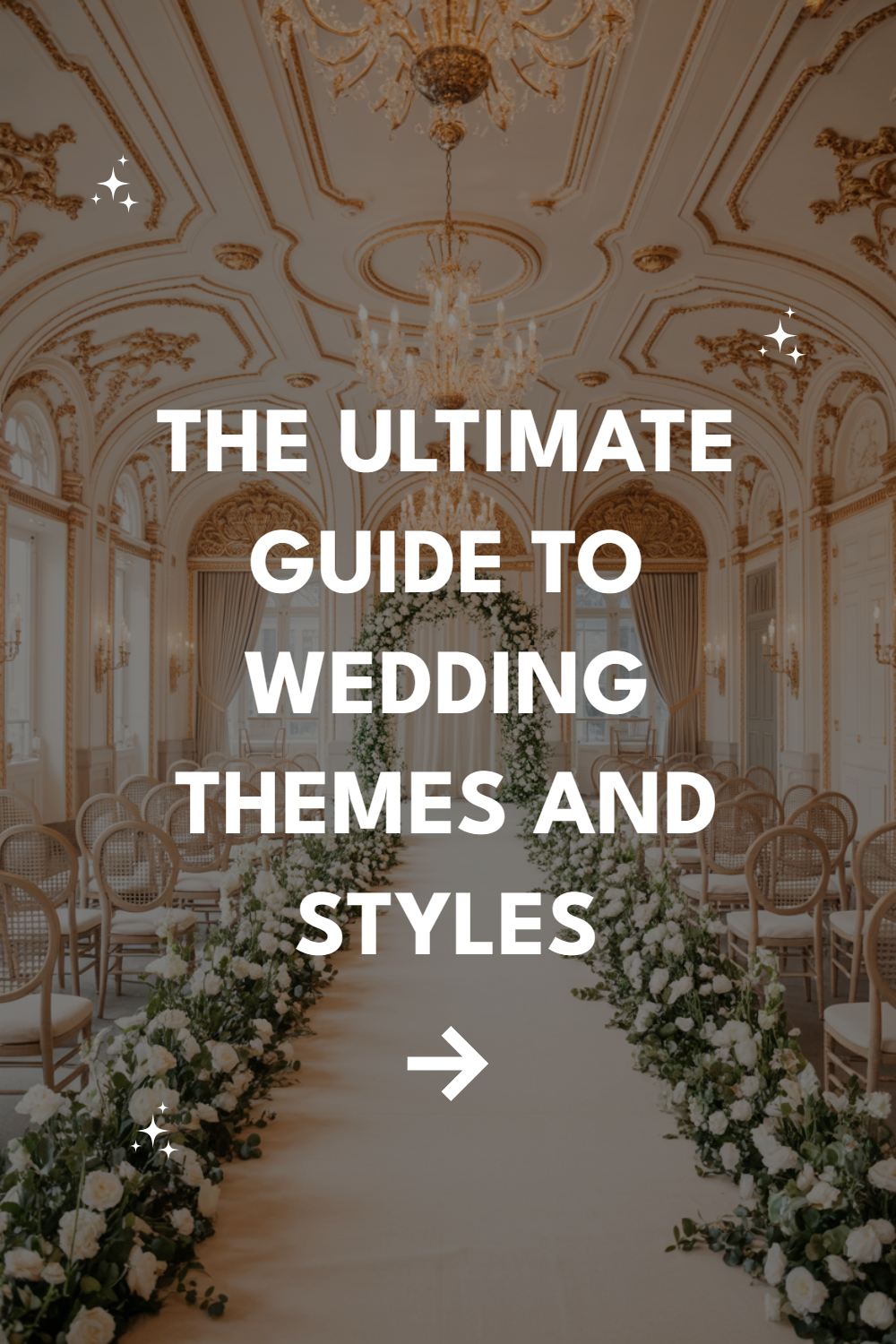Planning a wedding feels like standing in front of an endless Pinterest board, doesn’t it? Every scroll reveals another “must-have” theme that somehow makes your current vision feel completely wrong.
Here’s the truth: your wedding theme isn’t about following trends or impressing strangers on social media. It’s about creating a day that feels authentically you, whether that’s barefoot on a beach or dancing under crystal chandeliers.
Classic Elegance Never Goes Out of Style
Traditional wedding themes exist for a reason—they work beautifully and photograph timelessly. Think crisp white linens, ivory roses, and that sophisticated simplicity that makes your grandmother tear up with pride.
Classic doesn’t mean boring, though. You can elevate traditional elements with unexpected touches like vintage family photos as centerpieces or handwritten vows displayed in antique frames.
The beauty lies in the restraint and the focus on timeless details that won’t make you cringe in twenty years.
Timeless Color Palettes That Photograph Beautifully
Ivory, champagne, and blush create that dreamy, romantic atmosphere without screaming “trendy.” These colors work in any season and complement every skin tone in your wedding party.
Navy and gold offer a more sophisticated alternative to basic black and white. This combination photographs gorgeously and works equally well for morning ceremonies and evening receptions.
Traditional Elements with Modern Twists
Cathedral veils paired with sleek, minimalist gowns create stunning contrast. You get the drama of tradition without feeling like you’re wearing a costume from another era.
Classic string quartets can play contemporary songs, giving guests that “wait, is that Ed Sheeran?” moment. It’s familiar yet surprising, which is exactly what memorable weddings deliver.
Rustic Romance for the Nature-Loving Couple
Barn weddings and outdoor celebrations have evolved far beyond mason jars and burlap (though those still have their place). Modern rustic themes blend natural textures with refined details.
The key is balancing rustic elements with enough sophistication that your city friends don’t feel like they’re attending a county fair. Think wooden farm tables with elegant place settings, or string lights paired with lush floral arrangements.
Venue Selection Makes or Breaks Rustic Themes
Actual working farms often provide the most authentic backdrop, but make sure they have proper facilities. Nobody wants to trek through mud in heels to reach a questionable bathroom situation.
Converted barns offer rustic charm with modern amenities. These venues typically include tables, chairs, and climate control—luxuries that outdoor celebrations sometimes lack.
Natural Decor Elements That Create Atmosphere
Greenery garlands cost significantly less than elaborate floral arrangements while creating dramatic visual impact. Eucalyptus, ivy, and wild ferns bring that organic, just-picked feeling to any space.
Wood slice centerpieces topped with pillar candles provide rustic texture without blocking conversation across tables. Your guests will actually be able to see each other, which seems obvious but gets forgotten surprisingly often.
Bohemian Vibes for Free-Spirited Celebrations
Boho weddings embrace imperfection and celebrate individuality. Mismatched vintage furniture, flowing fabrics, and an overall “collected over time” aesthetic define this increasingly popular style.
This theme works particularly well for couples who hate rigid timelines and prefer relaxed celebrations. Boho weddings feel more like intimate gatherings than formal events, which some couples find much more appealing.
Textile Choices That Define Boho Style
Macrame backdrops and hanging installations create those Instagram-worthy ceremony spaces. These handmade elements add texture and visual interest without requiring expensive floral arrangements.
Layered rugs in ceremony spaces provide comfort for guests while establishing that relaxed, living-room vibe. Persian rugs, vintage kilims, and textured throws create cozy seating areas that encourage mingling.
Relaxed Timelines and Flowing Celebrations
Boho weddings often skip traditional reception timelines in favor of more organic celebrations. Cocktail hour might blend seamlessly into dinner, with dancing happening whenever the mood strikes.
This flexibility requires clear communication with vendors about timing expectations. Your photographer needs to understand that “golden hour portraits” might happen spontaneously rather than on a rigid schedule.
Modern Minimalist Weddings
Clean lines, neutral palettes, and carefully curated details define minimalist wedding themes. Less truly becomes more when every element serves a purpose and contributes to the overall aesthetic.
Minimalist weddings require more planning than they appear to need. Each detail matters significantly more when you’re working with fewer elements overall.
Venue Selection for Clean Aesthetics
Modern art galleries and contemporary event spaces provide the perfect backdrop for minimalist celebrations. These venues often feature interesting architecture that serves as natural decor.
Industrial lofts with exposed brick and concrete floors create striking contrast when paired with simple, elegant details. The venue’s existing character eliminates the need for extensive decoration.
Strategic Use of Negative Space
Empty space becomes a design element in minimalist weddings. Sparse table settings and clean ceremony spaces create calm, sophisticated atmospheres that feel intentionally curated.
Single-stem centerpieces or small potted plants provide just enough visual interest without overwhelming the clean aesthetic. Your guests’ attention focuses on each other rather than competing with busy decor.
Vintage-Inspired Celebrations
Vintage themes transport guests to another era through carefully chosen details and authentic elements. Whether you’re channeling the 1920s or 1950s, consistency in your chosen decade creates immersive experiences.
True vintage style requires research and attention to historical accuracy. Half-hearted attempts at vintage themes often feel more like costume parties than elegant celebrations.
Authentic Vintage Elements vs. Vintage-Inspired
Genuine vintage rentals and family heirlooms provide authenticity that reproductions can’t match. Grandmother’s china, vintage jewelry, and antique furniture tell stories that mass-produced “vintage-style” items simply can’t.
Vintage-inspired elements work well when authentic pieces aren’t available or practical. Modern reproductions often provide better functionality while maintaining the desired aesthetic.
Era-Specific Details That Transport Guests
1920s themes call for art deco patterns, feathers, and jazz music. Gold and black color schemes with geometric patterns create that Great Gatsby atmosphere everyone recognizes.
1950s celebrations embrace pastel colors, retro fonts, and swing music. Think pink and mint green, polka dots, and classic cars for transportation between venues.
Seasonal Theme Considerations
Each season offers unique opportunities and challenges for wedding themes. Spring celebrations can embrace fresh flowers and pastel colors, while winter weddings might feature rich jewel tones and cozy textures.
Seasonal themes feel natural and often cost less because you’re working with nature rather than against it. December weddings naturally incorporate evergreen and metallic elements, while June celebrations can showcase abundant garden flowers.
Spring and Summer Outdoor Possibilities
Garden party themes work beautifully during warmer months. Outdoor ceremonies surrounded by blooming flowers require minimal additional decoration while providing stunning natural backdrops.
Beach weddings offer built-in beauty but require careful planning for wind, sand, and sun exposure. Provide guests with flip-flops, sunscreen, and programs that won’t blow away during the ceremony.
Fall and Winter Indoor Celebrations
Autumn weddings can embrace rich colors and seasonal elements like pumpkins, leaves, and harvest themes. These natural decorations often cost less than traditional floral arrangements while providing abundant texture and color.
Winter celebrations call for cozy elements like fur throws, warm lighting, and rich fabrics. Candlelight becomes especially important during shorter days, creating intimate atmospheres that feel magical rather than dark.
Budget-Friendly Theme Strategies
Wedding themes don’t require unlimited budgets to look expensive and well-executed. Strategic choices and creative solutions can achieve high-impact results without breaking the bank.
Focus your budget on elements that provide the biggest visual impact. Ceremony backdrops and centerpieces create more dramatic effect than small detail items that guests might not even notice.
DIY Elements That Actually Work
Handmade signage and paper goods provide personal touches while saving money. Calligraphy skills aren’t required—simple, consistent fonts printed on quality paper look professional and intentional.
Homemade favors like cookies, jam, or small potted plants feel more meaningful than purchased trinkets. Guests actually use and appreciate edible or living favors rather than adding them to junk drawers.
Splurge vs. Save Decision Making
Photography deserves budget priority because these images last forever. Flowers, while beautiful, only last one day and shouldn’t consume disproportionate budget percentages.
Venue selection impacts every other budget category. Expensive venues often require additional rentals, while all-inclusive locations might actually save money despite higher initial costs.
Mixing Themes Without Creating Chaos
Combining elements from different themes can create unique, personalized celebrations when done thoughtfully. The key lies in identifying common threads that tie disparate elements together.
Color palettes serve as excellent unifying factors when mixing themes. Rustic wooden elements and elegant gold accents work together when connected through consistent color choices.
Finding Common Ground Between Styles
Texture provides another way to blend different theme elements successfully. Rough wooden tables can support elegant china and crystal when the textures complement rather than compete with each other.
Scale matters when combining theme elements. Large rustic pieces balanced with delicate details create interesting contrast, while competing elements of similar scale often look chaotic and unplanned.
Creating Cohesion Through Consistent Details
Repeated elements throughout the celebration create visual continuity. The same ribbon used on invitations, programs, and centerpieces ties everything together even when other elements vary significantly.
Font choices provide subtle consistency that guests notice subconsciously. Using the same two or three fonts on all printed materials creates professional cohesion regardless of your chosen theme.
Making Your Theme Choice
Stop overthinking this decision. Your wedding theme should reflect your personalities and relationship, not current Pinterest trends or family expectations.
Consider your venue first, then choose themes that complement rather than fight against the existing space. Rustic themes work beautifully in barns but might feel forced in sleek hotel ballrooms.
Trust your instincts about what feels right for your celebration. If you’re drawn to multiple themes, look for ways to blend them rather than abandoning elements you love. Your wedding should tell your story, whatever that looks like.


